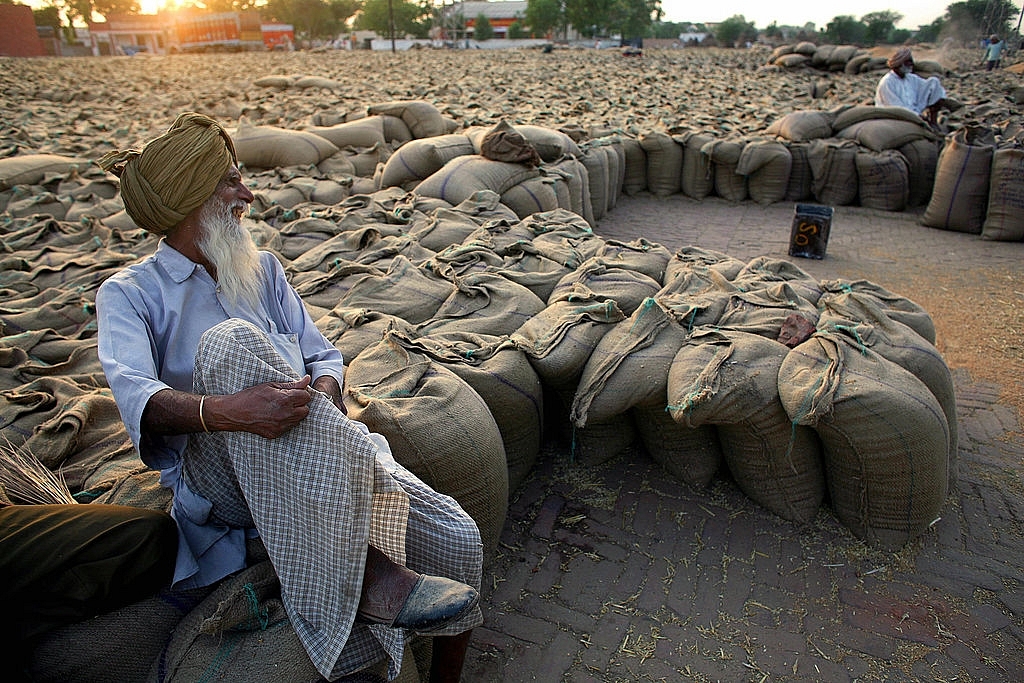Economy
Instead Of Throwing Money On Loan Waivers, Why Not Give Generous MSP Hikes?
- Higher minimum support prices versus farm loan waivers – why this is a debate worth having.

An Indian farmer relaxes at a grain market near Hamirgarh, Punjab (PEDRO UGARTE/AFP/Getty Images)
After Union Finance Minister Arun Jaitley announced in his budget speech that the government will offer farmers a minimum support price (MSP) for their crops that will be 1.5 times the production cost, a debate ensued: what did he mean by “production cost”, “A2”, “A2+FL”, or “C2”?
Costs borne by farmers, in cash and in kind, on seeds, fertilisers, fuel, irrigation, hired labour and so on are covered under A2. The A2+FL component refers to the imputed value of unpaid family labour in addition to A2 costs. And C2 is a more comprehensive term which includes rental foregone by farmers on their land or interest foregone for fixed capital assets over and above A2+FL.
Since then, the government has clarified that it intended to set prices one and a half times the A2+FL cost. Farmers’ organisations are not too happy about this. The MSP hike promise will impact a small section of farmers rearing kharif crops, as rabi crops are already getting prices higher than what the government is now promising.
Agriculture economist and chief architect of India’s Green Revolution, M S Swaminathan, says the government should have taken C2 as an anchor rather than A2+FL. He has been a votary of generous MSP hikes for a long time. More than a decade ago, he had proposed his formula of MSP and suggested that the price be 50 per cent more than the weighted average cost of production.
While many have often wondered what exactly the report meant by “weighted average cost of production”, Swaminathan is clear. In an interview to Hindustan Times, he said, “When we recommended 50 per cent over costs, we meant complete costs called C2, which includes all assumed costs. In fact that is what the farmers are also demanding.”
Since the Swaminathan report came out, every politician and party has sworn by it and vows to implement the proposal once in power. But no one dares deliver.
The reasons are obvious. The Swaminathan formula will require a big increase in MSPs, which can distort markets and lead to steep inflation. But what if the government were to directly credit the money in the accounts of farmers instead of artificially hiking the price at mandis? That can certainly reduce the potential for distortion of the market and won’t have much impact on inflation as well.
The other concern is obviously the higher cost to exchequer. Wouldn’t hiking the MSP put a great deal of burden on the government’s coffers?
In his Hindustan Times interview, Swaminathan says this is still better than throwing money on loan waivers. “Many governments are announcing loan waivers. Instead of spending so much on loan waivers, the government should use the money to give 50 per cent profits based on C2 costs.”
In the current fiscal year alone, four states have waived off farm loans worth Rs 88,000 crore. We may witness more states jump into this populist madness as we get closer to the 2018 assembly and 2019 general elections. Is Swaminathan right? Is it better to offer an MSP hike than throw money on loan waivers?
The State Bank of India’s Ecowrap report recently arrived at the same conclusion. The economists estimated the costs for the government to pay the farmers for select crops to an amount equivalent to the difference between wholesale price and MSP across states. Their findings suggested that the cost to state exchequer would be only 11 per cent of the total farm loan waiver amount declared by Uttar Pradesh, Maharashtra, Punjab, and Karnataka. Even if we take into account the fact that loan waivers are a once-in-a-decade phenomenon, this is a good trade-off.
Add to this the increased MSP hike. According to the SBI report, the combined cost will come to around Rs 20,000 crore. If divided equally between the centre and states, isn’t it better than farm loan waivers, which are costlier than the cost of their monetary component? A higher MSP may also help farmers avoid the debt trap they so often find themselves in and obviate the need for waivers in the future or, at least, make them less frequent.
It’s a trade-off worth considering.
Support Swarajya's 50 Ground Reports Project & Sponsor A Story
Every general election Swarajya does a 50 ground reports project.
Aimed only at serious readers and those who appreciate the nuances of political undercurrents, the project provides a sense of India's electoral landscape. As you know, these reports are produced after considerable investment of travel, time and effort on the ground.
This time too we've kicked off the project in style and have covered over 30 constituencies already. If you're someone who appreciates such work and have enjoyed our coverage please consider sponsoring a ground report for just Rs 2999 to Rs 19,999 - it goes a long way in helping us produce more quality reportage.
You can also back this project by becoming a subscriber for as little as Rs 999 - so do click on this links and choose a plan that suits you and back us.
Click below to contribute.
Latest